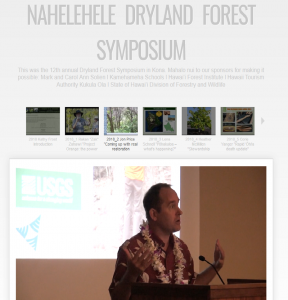Strategic Focus Areas:
Continual advocacy and education on the plight of Hawaii’s dryland ecosystems has borne many fruits since the Dryland Forest Working Group, the Hawaii Forest Industry Association, Nāhelehele and others first began efforts to save these ecosystems. Many more individuals and organizations have taken up the call to protect and restore a growing number of dryland sites across Hawaii, from makai to mauka. However, there is still much more to be done to ensure the long term survival of the dry forest ecosystem, which is why Nāhelehele is focusing its efforts on the following education, conservation, advocacy and restoration strategic areas:
Nāhelehele Dryland Forest Symposium

Dr. Jonathan Price 2018 talk on restoration baselines.
Since 2007, the annual Nāhelehele Dryland Forest Symposium has brought together researchers, conservationists, students and the general public to learn about dry forests and strengthen networking in the community. Best practices are shared on restoration and maintenance of this threatened habitat and its biodiversity.
The Symposium features presentations by community and cultural stewards, educators, researchers, and conservationists, and includes a Key Note speaker distinguished in their field of expertise. Presenters share their knowledge of this ecosystem, as well as ways the community can help to preserve and restore remaining dry forests. One or more field trips to dry forest sites are also offered before or after the day of the Symposium to enhance learning opportunities.
Please visit the following page to find out more about the Symposium: Symposium Info
There is a great deal of dry forest ecosystem information in the numerous videos of past Symposium presentations since 2011. Please see a list of these presentations in the following link: Nāhelehele Dryland Forest Symposium Videos
The Hawaii Island Seed Bank

Juanita Thompson prepares seed for drying.
As the only publicly available seed bank on Hawaii Island, the seed bank provides valuable services to conservation organizations involved in dry forest restoration and native plant conservation. The services provided by the seed bank include:
- mechanical cleaning of seed including removal of seed husks and dead seeds from the collection
- preparing and drying seed to optimal levels to enhance seed longevity in storage,
- data basing of seed with all pertinent information on species, source, quantity, date stored, etc.
- placement in appropriate packaging then storage in a walk-in cooler or a freezer, both with double power backup for added security
- determination of seed viability through germination testing.
The seed bank also helps with state wide research on how long native seeds can be safely stored before losing their viability, which is very important for species conservation. These services help ensure the survival of the many rare and endangered plants in the dry forest ecosystem, as well as providing a secure source of seeds for ongoing restoration efforts and mitigation for fire and drought. Another key effort of the seed bank is collecting and storing ʻōhiʻa seeds from all varieties and geographic zones on Hawai’i Island for future restoration efforts, as mitigation for Rapid ʻŌhiʻa Death.
For more information on the Seed Bank, please refer to the Seed Bank page.
Dry Forest Corridors
 Dry forest restoration is underway at a number of sites in West Hawaii, which is very encouraging and promising, yet these sites are far apart and fragmented. To ensure the continual perpetuation of dry forests, there is more that needs to be done. When sites are fragmented and isolated from one another, it inhibits species migration and genetic diversification which is essential for the long term health and survival of the native species in these habitats.
Dry forest restoration is underway at a number of sites in West Hawaii, which is very encouraging and promising, yet these sites are far apart and fragmented. To ensure the continual perpetuation of dry forests, there is more that needs to be done. When sites are fragmented and isolated from one another, it inhibits species migration and genetic diversification which is essential for the long term health and survival of the native species in these habitats.
To address this fragmentation, Nāhelehele is focusing both advocacy and restoration efforts on the establishment of dry forest corridors to begin linking dry forest remnants. This includes restoration efforts along a dry forest corridor in Waimea, as well as ongoing advocacy for the development of an open space network with dry forest corridors in the Kona region. Corridors which interconnect Hawaii’s open spaces and planted with native species not only ensure survival of our native ecosystems, but also provide trails and pathways for all life to thrive and enjoy the beauty and serenity of our native environments.
For more information on Dry Forest Corridors, please refer to the Corridors page.
